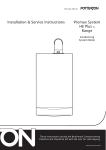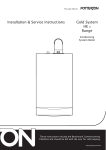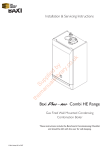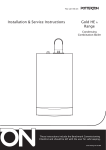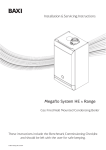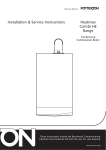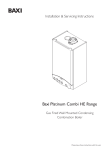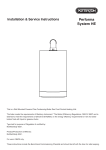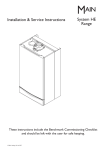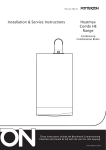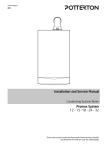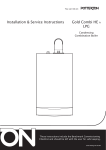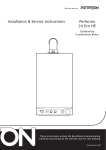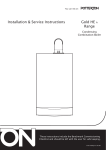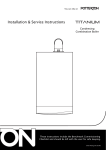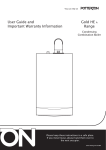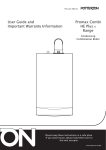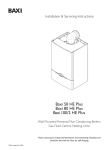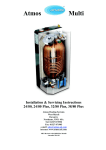Download Baxi Potterton LPG Technical data
Transcript
You can rely on Installation & Service Instructions Promax System HE Plus LPG Condensing System Boiler These instructions include the Benchmark Commissioning Checklist and should be left with the user for safe keeping. © Baxi Heating UK Ltd 2008 Propane Building Regulations and the Benchmark Commissioning Checklist Potterton Promax System 24 HE Plus LPG G.C.No 41 592 11 Building Regulations (England & Wales) require notification of the installation of a heating appliance to the relevant Local Authority Building Control Department. From 1 April 2005 this can be achieved via a Competent Persons Self Certification Scheme as an option to notifying the Local Authority directly. Similar arrangements will follow for Scotland and will apply in Northern Ireland from 1 January 2006. CORGI operate a Self Certification Scheme for gas heating appliances. These arrangements represent a change from the situation whereby compliance with Building Regulations was accepted as being demonstrated by completion of the Benchmark Logbook (which was then left on site with the customer). With the introduction of Self Certification Schemes, the Benchmark Logbook is being withdrawn. However, a similar document in the form of a commissioning checklist and service interval record is incorporated at the back of these instructions. This company is a member of the Benchmark initiative and fully supports the aims of the programme. Its aim is to improve the standards of installation and commissioning of central heating systems in the UK and to encourage the regular servicing of all central heating systems to ensure safety and efficiency. Building Regulations require that installations should comply with manufacturer's instructions. It is therefore important that the commissioning checklist is completed by the installer. The relevant section of Building Regulations only relates to dwellings. Therefore the checklist only applies if the appliance is being installed in a dwelling or some related structure. © Baxi Heating UK Ltd 2008 All rights reserved. No part of this publication may be reproduced or transmitted in any form or by any means, or stored in any retrieval system of any nature (including in any database), in each case whether electronic, mechanical, recording or otherwise, without the prior written permission of the copyright owner, except for permitted fair dealing under Copyrights, Designs and Patents Act 1988. The flowchart opposite gives guidance for installers on the process necessary to ensure compliance with Building Regulations. Applications for the copyright owner’s permission to reproduce or make other use of any part of this publication should be made, giving details of the proposed use, to the following address: The Company Secretary, Baxi Heating UK Ltd, The Wyvern Business Park, Stanier Way, Derby, DE21 6BF. Full acknowledgement of author and source must be given. WARNING: Any person who does any unauthorised act in relation to a copyright work may be liable to criminal prosecution and civil claims for damages. “Potterton” supports Baxi Heating UK Ltd is a BS-EN ISO 9001 Accredited Company This product has an energy rating (A) on a scale of A to G. For more information see www.boilers.org.uk. This is a certification mark. 2 © Baxi Heating UK Ltd 2008 The code of practice for the installation, commissioning & servicing of central heating systems. Installer Notification Guidelines Choose Building Regulations Notification Route Competent Person's Self Certification Scheme Building Control Install and Commission this appliance to manufacturer's instructions Contact your relevant Local Authority Building Control (LABC) who will arrange an inspection or contact a government approved inspector Complete the Benchmark Checklist If you notify via CORGI Scheme, CORGI will then notify the relevant Local Authority Building Control Scheme on member's behalf Install and Commission this appliance to manufacturer's instructions Scheme Members only Call CORGI on: 0800 408 1007 or log onto: www.corgi-notify.com within 10 days Complete the Benchmark Checklist You must ensure that the notification number issued by CORGI is written onto the Benchmark Checklist CORGI will record the data and will send a certificate of compliance to the property © Baxi Heating UK Ltd 2008 LABC will record the data and will issue a certificate of compliance 3 Legislation IMPORTANT - Installation, Commissioning, Service & Repair This appliance must be installed in accordance with the manufacturer’s instructions and the regulations in force. Read the instructions fully before installing or using the appliance. In GB, this must be carried out by a competent person as stated in the Gas Safety (Installation & Use) Regulations. Definition of competence: A person who works for a CORGI registered company and holding current certificates in the relevant ACS modules, is deemed competent. In IE, this must be carried out by a competent person as stated in I.S. 813 “Domestic Gas Installations”. The addition of anything that may interfere with the normal operation of the appliance without express written permission from the manufacturer or his agent could invalidate the appliance warranty. In GB this could also infringe the Gas Safety (Installation and Use) Regulations. Warning - Check the information on the data plate is compatible with local supply conditions. All CORGI registered installers carry a CORGI identification card and have a registration number. You can check your installer is registered by telephoning 0800 915 0485 or writing to:1 Elmwood, Chineham Park, Crockford Lane, Basingstoke. RG24 8WG or check online at www.trustcorgi.com The boiler meets the requirements of Statutory Instrument “ The Boiler (Efficiency) Regulations 1993 No 3083” and is deemed to meet the requirements of Directive 92/42/EEC on the energy efficiency requirements for new hot water boilers fired with liquid or gaseous fuels:Type test for purpose of Regulation 5 certified by: Notified Body 0085. Product/Production certified by: Notified Body 0086. For GB/IE only. 4 © Baxi Heating UK Ltd 2008 This company declare that no substances harmful to health are contained in the appliance or used during appliance manufacture. The appliance is suitable only for installation in GB and IE and should be installed in accordance with the rules in force, and only used in a suitably ventilated location. In GB, the installation must be carried out by a CORGI Registered Installer. It must be carried out in accordance with the relevant requirements of the: • Gas Safety (Installation & Use) Regulations. • The appropriate Building Regulations either The Building Regulations, The Building Regulations (Scotland), Building Regulations (Northern Ireland). • The Water Fittings Regulations or Water Byelaws in Scotland. • The Current I.E.E. Wiring Regulations. Where no specific instructions are given, reference should be made to the relevant British Standard Code of Practice. In IE, the installation must be carried out by a competent Person and installed in accordance with the current edition of I.S. 813 ‘Domestic Gas Installations’, the current Building Regulations and reference should be made to the current ETCI rules for electrical installation. All systems must be thoroughly flushed and treated with inhibitor (see section 6.2). Codes of Practice - refer to the most recent version In GB the following Codes of Practice apply: Standard Scope BS 5482 Part 1 Gas Installation. BS 5546 Installation of hot water supplies for domestic purposes. BS 5449 Forced circulation hot water systems. BS 6798 Installation of gas fired hot water boilers. BS 5440 Part 1 Flues. BS 5440 Part 2 Ventilation. BS 5482 Part 1 Domestic butane and propane gas burning installations. BS 7074 Expansion vessels and ancillary equipment for sealed water systems. BS 7593 Treatment of water in domestic hot water central heating systems. In IE the following Codes of Practice apply: Standard Scope I.S. 813 Domestic Gas Installations. The following standards give valuable additional information; BS 5482 Part 1 Domestic butane and propane gas burning installations. BS 5546 Installation of hot water supplies for domestic purposes. BS 5449 Forced circulation hot water systems. BS 7074 Expansion vessels and ancillary equipment for sealed water systems. BS 7593 Treatment of water in domestic hot water central heating systems. Safe Manual Handling General The following advice should be adhered to, from when first handling the boiler to the final stages of installation, and also during maintenance. Most injuries as a result of inappropriate handling and lifting are to the back, but all other parts of the body are vulnerable, particularly shoulders, arms and hands. Health & Safety is the responsibility of EVERYONE. There is no ‘safe’ limit for one man - each person has different capabilities. The boiler should be handled and lifted by TWO PEOPLE. Do not handle or lift unless you feel physically able. Wear appropriate Personal Protection Equipment e.g. protective gloves, safety footwear etc. Preparation Co-ordinate movements - know where, and when, you are both going. Minimise the number of times needed to move the boiler - plan ahead. Always ensure when handling or lifting the route is clear and unobstructed. If possible avoid steps, wet or slippery surfaces, unlit areas etc. and take special care on ladders/into lofts. Technique When handling or lifting always use safe techniques - keep your back straight, bend your knees. Don’t twist - move your feet, avoid bending forwards and sideways and keep the load as close to your body as possible. Where possible transport the boiler using a sack truck or other suitable trolley. Always grip the boiler firmly, and before lifting feel where the weight is concentrated to establish the centre of gravity, repositioning yourself as necessary. See the ‘Installation’ section of these instructions for recommended lift points. Remember The circumstances of each installation are different. Always asses the risks associated with handling and lifting according to the individual conditions. If at any time when installing the boiler you feel that you may have injured yourself STOP !! DO NOT ‘work through’ the pain - you may cause further injury. IF IN ANY DOUBT DO NOT HANDLE OR LIFT THE BOILER - OBTAIN ADVICE OR ASSISTANCE BEFORE PROCEEDING !! © Baxi Heating UK Ltd 2008 5 CONTENTS Section 6 © Baxi Heating UK Ltd 2008 Page 1.0 Introduction 7 2.0 General Layout 8 3.0 Appliance Operation 9 4.0 Technical Data 10 5.0 Dimensions and Fixings 11 6.0 System Details 12 7.0 Site Requirements 14 8.0 Flue Options 18 9.0 Plume Displacement 23 10.0 Installation 27 11.0 Commissioning 32 12.0 Completion 34 13.0 Servicing 35 14.0 Changing Components 37 15.0 Combustion Check 45 16.0 Electrical 46 17.0 Short Parts List 47 18.0 Fault Finding 48 Benchmark Checklist 54 1.0 Introduction 1.1 Description 1. The Potterton Promax System HE Plus LPG is a fully automatic gas fired wall mounted condensing system boiler. It is room sealed and fan assisted. Case Front Panel 2. The boiler is set to give a maximum output of :24 kW 25.9 kW (Condensing) 3. It is designed for use on Propane (G31). 4. The boiler incorporates a circulating pump and expansion vessel. It is suitable for use only on fully pumped sealed systems. 5. The boiler data badge gives details of the model, serial number and Gas Council number and is situated on the inner door panel. It is visible when the case front panel is removed (Fig. 1). 6. The boiler model name and serial number are also shown on the information label on the rear of the lower door panel. This is for user reference. 7. The boiler is intended to be installed in residential / commercial / light industrial E.M.C. environments on a governed meter supply only. Control Box 8. The boiler must be installed with one of the purpose designed flues such as the standard horizontal flue kit, part no. 5118489. Fig. 1 Data Badge 9. All systems must be thoroughly flushed and treated with inhibitor (see section 6.2). Information Label 1.2 Contents of Pack The pack contains:• Boiler • Wall Plate (including taps) • Set of Pipe Connections • Template • Literature Pack © Baxi Heating UK Ltd 2008 7 2.0 General Layout 2.1 Layout 22 1 14 21 13 12 20 15 19 6 9 8 7 11 1. Expansion Vessel 2. Automatic Air Vent 3. Circulation Pump 4. Drain Off Point 5. Pressure Relief Valve 6. Selector Switch 7. Central Heating System Pressure Gauge 8. PCB 9. Control Box 10. Gas Valve 11. Condensate Trap 12. Flame Sensing Electrode 13. Spark Electrode 14. Primary Heat Exchanger 15. Fan Assembly 16. On/Off/Reset Selector Switch 17. Central Heating Temperature Control 18. Calibration Control 19. Venturi 20. Air/Gas Collector 21. Combustion Box Cover & Burner 22. Igniter 23. Burner On Light 24. Central Heating Mode Light 25. Display 2 10 4 3 5 24 2 Reset 1 3 4 0 bar 16 8 © Baxi Heating UK Ltd 2008 25 23 17 18 7 3.0 Appliance Operation 3.1 Operating Mode (Fig. 2) Boiler Primary Circuit 1. With a demand for heating or hot water, the pump circulates water through the primary circuit. If the pressure is at least 0.5 bar and the ignition sequence will start. 1 2. When the flow temperature exceeds the setting temperature, a 3 minute delay occurs before the burner relights automatically (anti-cycling). The pump continues to run during this period. 2 20 18 3 3. When the demand is satisfied the burner is extinguished and the pump continues to run for a period of 3 minutes (Pump Overrun). 4 19 5 7 6 IMPORTANT: When the selector switch is in the ‘0’ (Off) position the electrical supply to the boiler is isolated. The boiler will not operate. 17 3.2 16 9 15 8 14 1. The frost protection mode is integral to the appliance and functions when the selector switch (see Section 2.1) is in the ON position ( ). If the system temperature falls below 5° C then the boiler will fire on its minimum setting until a flow temperature of 30° C is reached. Further protection can be incorporated by using a system frost thermostat. 3.3 11 Key 1 2 3 4 5 6 7 8 9 10 11 12 13 14 15 16 17 18 19 20 Frost Protection Mode 13 10 12 Pump Protection 1. With the selector switch (see Section 2.1) in the ON position ( ) the pump will automatically operate for 1 minute in every 24 hours to prevent sticking. Fig. 2 Heat Exchanger Burner Ignition Electrode Flame Sensing Electrode Gas Valve Pump Automatic Air Vent Pressure Relief Valve Boiler Drain Point Gas Inlet Boiler Flow Boiler Return Pressure Gauge Automatic By-Pass Water Pressure Sensor Safety Thermostat Temperature Sensor Expansion Vessel Return Temperature Sensor Fan © Baxi Heating UK Ltd 2008 9 4.0 Technical Data 4.1 Appliance Type C13 C33 C53 Promax System 24 HE Plus LPG Electrical Protection NOx Class IPX5D Appliance Category CAT I I 2H3P Heat Input (Net) 24 model kW Max 24.7 Heat Input (Gross) 24 model kW Max 27.4 Heat Output (Non-Condensing) Max 24 model kW 24 Max 25.9 kW Max Gas Rate (Propane - G31) (After 10 mins) kg/h 1.92 24 model 3A Min 7 Internal Fuse Rating F2L Min 7.8 Condensate Drain To accept 21.5mm (3/4 in) plastic waste pipe Safety Discharge Max Operating Min Operating Recommended Operating Range Flue Terminal Dimensions Pump Available Head Min 6.8 Min 7.4 Inlet Pressure (Propane - G31) mbar 37 Injector (Propane - G31) 24 model 7.5mm Electrical Supply 230V~ 50Hz (Appliance must be connected to an earthed supply) Power Consumption 24 model Central Heating Primary Circuit Pressures External Fuse Rating Heat Output (Condensing) 24 model 5 150W Diameter Projection Connections Gas Supply Central Heating Flow Central Heating Return Pressure Relief Discharge - Outercase Dimensions Casing Height Overall Height Inc Flue Elbow Casing Width Casing Depth Clearances Above Casing Below Casing Front Front L.H. Side R.H. Side 100mm 125mm bar 3 2.5 0.5 1-2 See graph below Expansion Vessel - (Integral with appliance) bar Min Pre-charge Pressure 0.5 copper tails 22mm 22mm 22mm 15mm litre - 780mm - 965mm - 450mm - 345mm Max Capacity of CH System 125 Primary Water Content of Boiler (unpressurised) 2.5 Temperatures Flow Temp (adjustable) 25°C to 80°C max (± 5°C) 200 mm Min 200 mm Min 450 mm Min (For Servicing) 5 mm Min (In Operation) 5 mm Min 5 mm Min (In Operation) Weights Packaged Boiler Carton Installation Lift Weight 24 model 44.2kg 39.2kg Pump - Available Head 5.5 5 4.5 4 SEDBUK Declaration For Promax System HE Plus 3.5 The seasonal efficiency (SEDBUK) for all models is:93.2% Band A (SAP) for energy rating of dwellings. The test data from which it has been calculated have been certified by 0085. Metre (wg) This value is used in the UK Government’s Standard Assessment Procedure 3 2.5 2 1.5 1 0.5 0 0 200 400 600 Flow Rate (l/h) 10 © Baxi Heating UK Ltd 2008 800 1000 1200 5.0 Dimensions and Fixings Dimensions At least 1.5° G E A 780mm B 345mm C 450mm D 116mm Ø Min. A E 185mm (207mm for 80/125mm flue systems) F 145mm G 131mm B 360° Orientation H 180mm H D C Tube Ø 100mm F Tap Rail 32.5 mm Condensate Drain 130 mm Heating Flow (22mm) © Baxi Heating UK Ltd 2008 130 mm Gas Inlet (22mm) 65 mm Heating Return (22mm) Pressure Relief Valve (15mm) 11 6.0 System Details 6.1 Central Heating Circuit 1. The appliance is suitable for fully pumped SEALED SYSTEMS ONLY. Treatment of Water Circulating Systems • All recirculatory water systems will be subject to corrosion unless an appropriate water treatment is applied. This means that the efficiency of the system will deteriorate as corrosion sludge accumulates within the system, risking damage to pump and valves, boiler noise and circulation problems. • When fitting new systems flux will be evident within the system, which can lead to damage of system components. • All systems must be thoroughly drained and flushed out. Using, for example Betz-Dearborn Sentinel X300 or X400 or Fernox Superfloc Universal Cleanser. They should be used following the flushing agent manufacturer’s instructions. • System additives - corrosion inhibitors and flushing agents/descalers should comply to BS7593 requirements, e.g. Betz-Dearborn Sentinel X100 and Fernox-Copal which should be used following the inhibitor manufacturer’s instructions. Failure to flush and add inhibitor to the system will invalidate the appliance warranty. • It is important to check the inhibitor concentration after installation, system modification and at every service in accordance with the manufacturer’s instructions. (Test kits are available from inhibitor stockists.) • For information or advice regarding any of the above contact Technical Enquiries. 6.2 Bypass 1. The boiler is fitted with an automatic integral bypass. 6.3 System Control 1. For optimum operating conditions, the heating system into which the boiler is installed should include a control system. 2. Such a system will comprise of a timer control and separate room or cylinder thermostats as appropriate. 3. The boiler should be controlled so that it operates on demand only. 4. Operation of the system under control of the boiler thermostat & TRV’s only does not produce the best results. 12 © Baxi Heating UK Ltd 2008 6.0 System Details 6.4 Stop Valve Double Check Valve Mains Cold Inlet Fig. 3 System Filling and Pressurising Sealed Systems 1. A filling point connection on the central heating return pipework must be provided to facilitate initial filling and pressurising and also any subsequent water loss replacement/refilling. Stop Valve Temporary Hose CH Return 2. The filling method adopted must be in accordance with all relevant water supply regulations and use approved equipment. 3. Your attention is drawn to the current edition of I.S. 813 “Domestic Gas Installations”. Filling Loop for Sealed Systems 4. The sealed primary circuits may be filled or replenished by means of a temporary connection between the circuit and a supply pipe, provided a ‘Listed’ double check valve or some other no less effective backflow prevention device is permanently connected at the inlet to the circuit and the temporary connection is removed after use. Header Tank Non-Return Valve ‘Semi - Sealed’ Systems 1. ‘Semi - Sealed’ systems require the use of a suitable header tank and ball cock arrangement to charge and provide subsequent replenishment of the system. 2. The tank must be placed to provide sufficient head in order to ensure a minimum system pressure of 0.2 bar. 3. A suitable non - return valve must be fitted in the pipework between the header tank and heating system. 6.5 Fig. 3a ‘Semi-Sealed’ System Expansion Vessel 1. The appliance expansion vessel is pre-charged to 0.5 bar. The vessel is suitable for correct operation for system capacities up to 125 litres. For greater system capacities an additional expansion vessel must be fitted. Refer to BS 7074 Pt 1. For IE, the current edition of I.S. 813 “Domestic Gas Installations”. CH Return 6.6 Pressure Relief Valve (Fig. 4) 1. The pressure relief valve is set at 3 bar, therefore all pipework, fittings, etc. should be suitable for pressures in excess of 3 bar and temperature in excess of 100°C. 2. The pressure relief discharge pipe should be not less than 1/2” dia, run continuously downward, and discharge outside the building, preferably over a drain. It should be routed in such a manner that no hazard occurs to occupants or causes damage to wiring or electrical components. The end of the pipe should terminate facing down and towards the wall. 3. The discharge must not be above a window, entrance or other public access. Consideration must be given to the possibility that boiling water/steam could discharge from the pipe. Fig. 4 Pressure Relief Valve Discharge Pipe © Baxi Heating UK Ltd 2008 13 7.0 Site Requirements 450mm 5mm Min 5mm Min 7.1 200mm Min (300mm Min if using 80/125mm flueing system) Location 1. The boiler may be fitted to any suitable wall with the flue passing through an outside wall or roof and discharging to atmosphere in a position permitting satisfactory removal of combustion products and providing an adequate air supply. The boiler should be fitted within the building unless otherwise protected by a suitable enclosure i.e. garage or outhouse. (The boiler may be fitted inside a cupboard-see Section 7.3). 2. If the boiler is sited in an unheated enclosure then it is recommended to leave the ON/OFF Selector Switch in the On position. 3. If the boiler is fitted in a room containing a bath or shower reference must be made to the relevant requirements. In GB this is the current I.E.E. Wiring Regulations and Building Regulations. In IE reference should be made to the current edition of I.S. 813 “Domestic Gas Installations” and the current ETCI rules. 780mm 4. If the boiler is to be fitted into a building of timber frame construction then reference must be made to the current edition of Institute of Gas Engineers Publication IGE/UP/7 (Gas Installations in Timber Framed Housing). 200mm Min Fig. 5 5. In accordance with BS6798 LPG fuelled appliances shall not be installed in rooms or internal spaces below ground level. 7.2 Clearances (Figs. 5 & 6) At least 1.5° 1. A flat vertical area is required for the installation of the boiler. 2. These dimensions include the necessary clearances around the boiler for case removal, spanner access and air movement. Additional clearances may be required for the passage of pipes around local obstructions such as joists running parallel to the front face of the boiler. 450mm Min For Servicing Purposes 5mm Min In Operation Fig. 6 14 © Baxi Heating UK Ltd 2008 7.0 Site Requirements 7.3 Ventilation of Compartments Gas Service Cock 1. Where the appliance is installed in a cupboard or compartment, no air vents are required. 2. BS 5440: Part 2 refers to room sealed appliances installed in compartments. The appliance will run sufficiently cool without ventilation. 7.4 Gas Supply 1. The gas installation should be in accordance with the relevant standards. In GB this is BS 5482-1. In IE this is the current edition of I.S. 813 “Domestic Gas Installations”. 2. The connection to the appliance is a 22mm copper tail located at the rear of the gas service cock (Fig. 7). Fig. 7 3. Ensure that the pipework from the meter to the appliance is of adequate size, and the demands of any other gas appliances in the property are taken into consideration. Do not use pipes of a smaller diameter than the boiler gas connection (22mm). Zone 2 Window Recess Zone 1 7.5 Electrical Supply Zone 2 Zone 3 1. External wiring must be correctly earthed, polarised and in accordance with relevant regulations/rules. In GB this is the current I.E.E. Wiring Regulations. In IE reference should be made to the current edition of ETCI rules. Zone 0 0.6 m 2.4 m Window Recess 2. The mains supply is 230V ~ 50Hz fused at 3A. Zone 2 NOTE: The method of connection to the electricity supply must facilitate complete electrical isolation of the appliance. Zone 3 Fig. A Connection may be via a fused double-pole isolator with a contact separation of at least 3mm in all poles and servicing the boiler and system controls only. In GB Only Ceiling Outside Zones Zone 2 Zone 3 Window Recess Zone 2 3.0 m 7.6 Outside Zones Zone 3 Zone 1 Zone 2 Zone 0 0.6 m Fig. B © Baxi Heating UK Ltd 2008 In GB Only 3. When the system includes an indirect domestic hot water cylinder it is recommended that a cylinder thermostat is used in conjunction with a 3 port 2 position valve or 2 port zone valve. 2.4 m 2.25 m Bath & Shower Rooms 1. If the boiler is fitted in a room containing a bath or shower and NOT FITTED with any optional integral timer or thermostat, it can be fitted in zone 2, (Figs. A & B shows zone dimensions for a bathtub. For other examples refer to Section 601 of the Current I.E.E. Wiring Regulations) reference must be made to the relevant requirements. In GB this is the current I.E.E. Wiring Regulations and Building Regulations. In IE reference should be made to the current edition of I.S. 813 “Domestic Gas Installations” and the current ETCI rules. 15 7.0 Site Requirements Termination to an internal soil and vent pipe Boiler 50mm per me tre of 2.5° M inimum 7.7 Condensate Drain FAILURE TO INSTALL THE CONDENSATE DISCHARGE PIPEWORK CORRECTLY WILL AFFECT THE RELIABLE OPERATION OF THE BOILER The condensate discharge pipe MUST NOT RISE at any point along its length. There MUST be a fall of AT LEAST 2.5° (50mm per metre) along the entire run. pipe ru n fall 1. The condensate outlet will accept 21.5mm (3/4in) plastic overflow pipe which should generally discharge internally into the household drainage system. If this is not possible, discharge into an outside drain is acceptable. 450mm min External termination via internal discharge branch e.g sink waste - downstream Boiler 2. Ensure the discharge of condensate complies with any national or local regulations in force. BS 6798:2000 & Part H1 of the Building Regulations give further guidance. 3. The discharge pipe should be run in a proprietary drain pipe material e.g. PVC, PVC-U, ABS, PVC-C or PP. 50mm Sink per me tre of 2.5° M inimum pipe ru n Pipe must terminate above water level but below surrounding surface fall 4. Metal pipework is NOT suitable for use in condensate discharge systems. 5. The pipe should be a minimum of 21.5mm diameter and must be supported using suitably spaced clips to prevent sagging. 6. It is advisable to keep the condensate pipe internal. 7. External runs greater than 3 metres or runs in cold areas should use 32mm waste pipe. Termination to a drain or gully Boiler Pipe must terminate above water level but below surrounding surface 50mm per me tre of 2.5° M n fall Termination to a purpose made soakaway Boiler 500mm min 50mm per me tre of 2.5° M inimum 16 © Baxi Heating UK Ltd 2008 pipe ru fall n 9. In all cases discharge pipe must be installed to aid disposal of the condensate. To reduce the risk of condensate being trapped, as few bends and fittings as possible should be used. 10. When discharging condensate into a soil stack or waste pipe the effects of existing plumbing must be considered. If soil pipes or waste pipes are subjected to internal pressure fluctuations when WC's are flushed or sinks emptied then back-pressure may force water out of the boiler trap and cause appliance lockout. pipe ru inimum 8. If the boiler is fitted in an unheated location the entire condensate discharge pipe should be treated as an external run. Holes in the soak-away must face away from the building Examples are shown of the following methods of termination:i) to an internal soil & vent pipe ii) via an internal discharge branch (e.g. sink waste) iii) to a drain or gully iv) to a purpose made soakaway Terminal Position with Minimum Distance (Fig. 9) (mm) Aa Directly below an opening, air brick, opening windows, etc. Ba Above an opening, air brick, opening window etc. Ca Horizontally to an opening, air brick, opening window etc. D Below gutters, soil pipes or drain pipes. E Below eaves. F Below balconies or car port roof. G From a vertical drain pipe or soil pipe. H From an internal or external corner. I Above ground, roof or balcony level. J From a surface or boundary line facing a terminal. K From a terminal facing a terminal (Horizontal flue). From a terminal facing a terminal (Vertical flue). L From an opening in carport (e.g. door, window) into the dwelling. M Vertically from a terminal on the same wall. N Horizontally from a terminal on the same wall. R From adjacent wall to flue (vertical only). S From an adjacent opening window (vertical only). T Adjacent to windows or openings on pitched and flat roof U Below windows or openings on pitched roofs 7.0 Site Requirements 300 300 300 25 25 25 25 25 300 600 1200 600 7.8 NOTE: Due to the nature of the boiler a plume of water vapour will be discharged from the flue. This should be taken into account when siting the flue terminal. 1. The following guidelines indicate the general requirements for siting balanced flue terminals. For GB recommendations are given in BS 5440 Pt 1. For IE recommendations are given in the current edition of I.S. 813 “Domestic Gas Installations”. 1200 1500 300 300 1000 600 2000 2. If the terminal discharges onto a pathway or passageway, check that combustion products will not cause a nuisance and that the terminal will not obstruct the passageway. 3. If a terminal is less than 2 metres above a balcony, above ground or above a flat roof to which people have access, then a suitable terminal guard must be provided. a In addition, the terminal should be no nearer than 150 mm to an opening in the building fabric formed for the purpose of accommodating a built-in element such as a window frame. See BS 5440 Pt. 1. IMPORTANT: • Only ONE 25mm clearance is allowed per installation. • Under car ports we recommend the use of the plume displacement kit. • The terminal position must ensure the safe and nuisance - free dispersal of combustion products. NOTE: The distance from a fanned draught appliance terminal installed parallel to a boundary may not be less than 300mm in accordance with the diagram below 300 min Terminal Assembly Flue * Plume Displacement Kit IMPORTANT: If fitting a Plume Displacement Flue Kit, the air inlet must be a minimum of 100mm from any opening windows or doors (see Section 9.0). Top View Rear Flue Fig. 8 Property Boundary Line J,K T Air Inlet U Opening Window or Door 100mm MIN. N R I M C I I F D E A S I F J,K B L G A A H Fig. 10 H I Likely flue positions requiring a flue terminal guard © Baxi Heating UK Ltd 2008 Fig. 9 17 8.0 Flue Options 8.1 Horizontal Flue Systems 1. The standard flue is suitable only for horizontal termination applications. 2. Maximum permissible equivalent flue lengths are:Y Horizontal Concentric 60/100 10 metres 80/125 20 metres 3. Any additional “in line” bends in the flue system must be taken into consideration. Their equivalent lengths are:Concentric Pipes: 135° bend 0.5 metres 93° bend 1.0 metres Twin Flue Pipe 135° bend 0.25 metres 91.5° bend 0.50 metres X Horizontal Flues The elbow connected to the boiler adaptor is not included in any equivalent length calculations 5. The illustrations opposite show examples of permissible flue systems. Plume Displacement 60 /100 dia Kit 1M Extensions 45° & 93° bends are also available - see Section 9.0 Plume Displacement. NOTE: Flue length is measured from point X to Y as shown. NOTE: Horizontal flue pipes should always be installed with a fall of at least 1.5° from the terminal to allow condensate to run back to the boiler. This bend is equivalent to 1 metre C A Y B X This bend is equivalent to 1 metre Total equivalent length = A+B+C+2x90°Bends 18 © Baxi Heating UK Ltd 2008 Vertical Flues (Twin Pipe) 8.0 Flue Options 8.2 Twin & Vertical Flue Systems Y 1. Maximum permissible equivalent flue lengths are:X Vertical Concentric Vertical Twin Pipe (60/100) 10 metres 15 metres (80/125) 20 metres 2. Any additional “in line” bends in the flue system must be taken into consideration. Their equivalent lengths are:Concentric Pipes: 135° bend 0.5 metres 93° bend 1.0 metres Twin Flue Pipe 135° bend 0.25 metres 91.5° bend 0.50 metres Vertical Flues The elbow supplied with the standard horizontal telescopic flue kit is not included in any equivalent length calculations Y NOTE: Flue length is measured from point X to Y as shown. X Total Equivalent Length = A+B+C+1x90°Bend Roof Terminal All vertical and angled runs must be included, measured from the boiler adaptor (point X) to the joint with the flue terminal (point Y). One 91.5° bend or two 45° bends can be included without reduction of the flue length. 660mm If further elbows are required the flue length must be reduced by the following amounts:- The total equivalent length for this example is = 6.5 metres. Y 1 metre for each 91.5° elbow 0.5 metre for each 45° elbow C B Equivalent Length Value 1m extension 45°bend 91.5°bend This bend is equivalent to 1 metre 1m 0.25m 0.5m AIR DUCT No of fittings/pipes 5 2 2 Sub total 5.0m 0.5m 1.0m Equivalent Length Air Duct = 6.5m A Equivalent Length Value X 1m extension 45°bend 91.5°bend 1m 0.25m 0.5m FLUE DUCT No of fittings/pipes 5 2 2 Sub total 5.0m 0.5m 1.0m Equivalent Length Flue Duct = 6.5m © Baxi Heating UK Ltd 2008 19 A3 8.0 Flue Options 8.3 A Key Accessory Size Code No FLUE GROUP A Concentric Flue System 100mm diameter A Horizontal Flue Terminal (incl elbow) 5118489 A2 Telescopic Flue (inc. elbow) 315-500mm 5119654 A3 Telescopic Internal Flue Kit 315-500mm 5119654 B Flue Extension 1000mm 5111074 C Flue Bend 93° 5111075 D Flue Bend (pair) 135° 5111085 U Pipe Support (painted) 100Ømm 5111080 R Vertical Flue Adaptor 5111070 P Wall Liner 5111067 S Flue Terminal Deflector 5111068 A4 A2 E B FLUE GROUP N Twin Flue System 80mm diameter E Flue Extension (pair) 1000mm F Flue Bend (pair) 90° G Flue Bend (2 pair) 135° J Vertical Flue Boiler Adaptor Kit H Vertical Flue Adaptor W Pipe Support (pair) 80mm Y Twin Flue Termination Kit (horizontal termination) 80mm P K1 D C G R F H M U,W,X L N S 20 © Baxi Heating UK Ltd 2008 J Flue Accessories 5111087 5111072 5111086 5111079 5111084 5111081 5120172 FLUE GROUP G Concentric Flue System 80/125mm diameter A4 Horizontal Flue Kit B Straight Extension Kit 1000mm D Bend Kit (pair) 135° C Bend 91.5° X Pipe support 125mm 5118580 5118584 5118597 5118588 5118610 FLUE GROUP A, N, G Vertical Flue Kits K1 Vertical Flue Terminal L Pitched Roof Flashing M Roof cover plate N Flat roof flashing 5118576 5122151 246143 246144 25°/50° 8.0 Flue Options For Twin Flue Systems fit the adaptors as follows:- 8.4 Flue Duct Adaptor 1. Engage the flue duct adaptor on the boiler flue adaptor, making sure that it is pushed down as far as possible. 8.5 Flue Duct Adaptor Blanking Plate Air duct adaptor 1. Undo the screws securing the blanking plate to the boiler top panel. Discard the plate. 2. There are three restrictor plates supplied in the kit. One marked ‘23’, one marked ‘27’ and a third unmarked. The unmarked one must be used with this 24kW boiler. Discard the other two. Position the unmarked restrictor as shown below. 3. Take one of the gaskets supplied in the kit and place on the boiler top panel. 4. Align the restrictor as shown. Position the second gasket over the restrictor. 5. Using the screws previously removed secure the inlet adaptor to the top panel. 6. Continue to fit the twin flue system. Inlet Adaptor Position of Restrictor Gasket 24 kW model Restrictor Gasket © Baxi Heating UK Ltd 2008 21 8.0 Flue Options 8.6 1. In the case of a pitched roof 25 - 50 degrees, position the lead tile to replace/flash over existing roof tiling. Make an aperture in the roof suitable for the lower tube of the roof terminal and ensure the integrity of the roof cover is maintained. The adjustable plastic collar can either be positioned on the lead tile or the lower tube of the roof terminal prior to the final positioning of the vertical flue through the tile. Check the collar is correctly located to suit required roof pitch (either 25° to 38° or 37° to 50°). From inside the roof adjust the flue to a vertical position and secure to the roof structure with the clamp supplied. Approx 1425mm Cut the same amount off the Air Duct & Flue Duct For Roof Terminals 2. For flat roof installations the aluminium flashing must be incorporated into the roof covering and the appropriate aperture made in the roof decking. The vertical flue is lowered onto the flashing making sure the collar of the flue locates securely with the flashing. (A mastic seal may be necessary). From inside the roof, adjust the flue to a vertical position and secure to the roof structure with the clamp supplied. Air Duct Flue Duct IMPORTANT: If the boiler is not fitted immediately after the flue system, temporary precautions must be taken to prevent rain entry into the room of installation. Any precautionary measures must be removed prior to commissioning the boiler. Push Fit Adaptor 8.7 Flue Dimensions The standard horizontal telescopic flue kit allows for lengths between 100mm and 685mm from elbow to terminal (Fig. 11). The maximum permissible equivalent flue length is: 10 metres (60/100 system) 20 metres (80/125 system) m m 85 6 m 0m 10 8.8 Flue Deflector Flue Trim 1. The rubber flue trim supplied may be fitted to either the outside wall or on the inner wall of installation. Fig. 11 8.9 Terminal Guard (Fig. 12) 1. When codes of practice dictate the use of terminal guards, they can be obtained from most Plumbers’ and Builders’ Merchants. 2. There must be a clearance of at least 50mm between any part of the terminal and the guard. 3. When ordering a terminal guard, quote the appliance name and model number. 4. The flue terminal guard should be positioned centrally over the terminal and fixed as illustrated. 8.10 Fig. 12 22 © Baxi Heating UK Ltd 2008 Flue Deflector 1. If required, push the flue deflector over the teminal end and rotate to the optimum angle for deflecting plume. Secure the deflector to the terminal with screws provided. 93° Elbow/Plume Outlet Assembly 60Ø Support Bracket O Ring 0.9 metres 60Ø Exhaust Flue Pipe 60Ø Support Bracket O Ring Fig. 13 Flexible Flue Trim Adaptor ‘Jubilee’ Clip O Ring 9.0 Plume Displacement 9.1 Plume Displacement Kit (Fig. 14) Kit No 5118638 (5121367 without elbow) Content of kit 1 0.9m 60/100 Concentric Flue 1 1m 60 Dia Exhaust Flue Pipe 1 Adaptor 2 60 Dia Support Brackets 1 93° Elbow/Plume Outlet Assembly 1 Flexible Flue Trim 3 “O” Rings 1 ‘Jubilee Clip 1 Elbow 1. This kit is recommended for installations where the condensate plume emitted from the flue may cause a nuisance or affect the surroundings. 2. The terminal must be positioned outside the building with the air inlet facing downward and outlet connection upwards. 60/100Ø Concentric Flue 45° 45° Outlet must be at least 45° from wall face Fig. 14 ‘Peak’ Uppermost 3. The plume outlet must always be at least 45° to the wall, with the ‘peak’ uppermost to prevent rain entry (Figs. 15 & 16), and be at least 2 metres above ground level. It must be secured as shown in Fig. 10. The plume outlet must also be at least 500mm from the air inlet in any direction (Fig. 16). NOTE: The outlet must be positioned so that any condensate plume is directed away from adjacent surfaces. There must be a constant fall along the entire length of the flue system from the outlet back to the boiler. 4. It is possible to reduce or increase (with the addition of extensions) the length of either or both the 60/100 concentric and 60Ø exhaust. 5. Standard concentric flue extension kits may be added between the boiler elbow and the terminal assembly. 6. The minimum length of the concentric flue is 100mm when measured from the edge of the flue elbow. 500mm Min. IMPORTANT: The maximum equivalent length of concentric flue is:- 8 metres Additional bends may be fitted in the concentric flue, but the equivalent length must be reduced by 1 metre (93° bend) or 0.5 metres (45° bend). Fig. 15 Air Inlet at Bottom Fig. 16 7. 60Ø 1 metre extensions (including support bracket), and additional 93° & 45° elbows are available. Any additional 93° & 45° elbows must be accounted for when calculating flue lengths. NOTE: Permitted positions of the plume outlet relative to doors, windows etc. are the same as for conventional concentric flues as detailed in the main Installation & Servicing Instructions and BS5440 Pt. 1. It is NOT necessary to fit a terminal guard over the air inlet or the plume outlet. © Baxi Heating UK Ltd 2008 23 16 14 14 12 60 Ø Exhaust (metres) X 60 Ø Exhaust (metres) X 16 24 10 8 6 9.0 Plume Displacement 12 24 10 9.2 6 4 4 2 2 0 0 0 3 2 1 4 5 6 7 8 Determining Permissible Lengths 8 0 9 1 3 2 4 5 6 7 8 9 In the graph the solid line diagonal represents the relationship between the concentric flue assembly (and any extensions) and the 60Ø exhaust (and any extensions or additional bends). Concentric 60/100 Flue (metres) Y Concentric 60/100 Flue (metres) Y Example 2 Flue Lengths - OK Example 1 Flue Lengths - Not Permissible Example 1 - Not Permissible If, for instance, a concentric length of 6 metres was required and the 60Ø exhaust needed to be 10 metres the graph shows that this combination would NOT be permissible as the intersection point would be above the solid diagonal line. 16 60 Ø Exhaust (metres) X 14 12 Example 2 - Flue Lengths OK Where both lengths have been determined they can be applied to the graph to check that the installation is permissible. For example, if it was known that 2 metres of concentric flue and 6 metres of 60Ø exhaust were required, the values could be applied to the graph as shown in Example 2. As the point of intersection of the dotted lines is below the solid diagonal line, the combination of lengths is shown to be acceptable. 24 10 8 6 4 2 0 0 1 3 2 4 5 6 7 8 9 Concentric 60/100 Flue (metres) Y Example 3 Flue Lengths - OK Support Bracket 60Ø Exhaust X Example 3 - Flue Lengths OK In the example shown, assume that the concentric part of the flue needs to be 8 metres long. Find the position of ‘8’ on the horizontal axis of the graph and then project upwards to the solid diagonal line. This is represented by the vertical thick dotted line. Where this dotted line intersects with the solid diagonal line on the graph, project across to the vertical axis. As can be seen this corresponds with 6 metres. Therefore, the total equivalent length of the 60Ø exhaust can be up to 6 metres. Any bend equivalencies must be accounted for i.e. 93° bends are equal to 1 metre, each 13 5° bend to 0.5 metres. 45° Elbow Y 93° Elbow Flue Length - Worked Example 1 metre Extension Concentric 60/100 Flue 1 metre supplied in kit In Fig. 18 opposite an additional 93° bend and pair of 45° bends have been included in the 60Ø exhaust. Also 3 straight extension pieces have been used. Fig. 17 Concentric Flue Additional Accessories A - 93° Elbow B - 45° Elbow (Pair) C - 1 metre 60Ø Extension 24 © Baxi Heating UK Ltd 2008 5121369 5121370 5121368 Fig. 18 To calculate total length:Length of 60Ø supplied in kit = 3 x 1 metre Extensions = 1 x 93° Elbow = 2 x 45° Elbow = 1 metre 3 metres 1 metre 1 metre (0.5 metres each) Total 60Ø = 6 metres After consulting the table in Example 3 it can be determined that the concentric flue could be up to 8 metres long. 9.0 Plume Displacement 9.3 General Fitting Notes 1. Cut a hole in the external wall which the concentric flue assembly will pass through. The hole should allow the flue to fall back to the boiler at an angle of at least1.5°. 2. When completed the terminal must be at least 2 metres above ground level (Fig. 19). Min. 2 metres 3. Measure and cut to size the concentric assembly and any extensions that are being used. 4. Insert the concentric assembly through the hole from outside the building. 5. If required, the flexible flue trim should be fitted prior to this as it cannot be fitted after. Use the large ‘Jubilee’ clip to secure the trim to the flue (See Fig. 20, trim shown dotted), with the screw part of the clip at the bottom. Fig. 19 6. Connect any extensions or elbows that are being used to the concentric assembly. Engage the extension, elbow or concentric assembly in the boiler flue elbow. Fit the boiler flue elbow to the boiler adaptor. Flue Trim 7. Ensure that the concentric assembly and any extensions fall back to the boiler at an angle of at least 1.5° and that the external air inlet is to the bottom. 8. Use suitable brackets to support the concentric assembly and any extensions, and make good inside and outside. Spigot 9. The 60Ø exhaust can now be fitted. Slide the adaptor over the plain end of the 60Ø exhaust (Fig. 22) and engage the exhaust in the terminal. Slide the adaptor down over the spigot. Mark and drill the adaptor, using a 2mm bit, as shown in Fig. 21. Secure the adaptor to the spigot using one of the screws supplied. Position of ‘Jubilee’ Clip screw Fig. 20 50mm Adaptor 10. If it is necessary to shorten the 60Ø exhaust or any of the extensions, the excess material must be cut from the plain end of the pipe. 11. Determine the position of the 60Ø exhaust and mark on the wall a suitable position for the support bracket. If extensions are being used, a support bracket is supplied in each kit. Fig. 22 30mm Fig. 21 12. Drill the wall, and fit the bracket(s) using the plug and screw provided. 13. Mark and drill the 60Ø exhaust, using a 2mm bit, as shown in Fig. 23. Complete the installation of the 60Ø exhaust, securing in the brackets. 30mm Fig. 23 14. Fit the 93° elbow/plume outlet and secure with the two remaining screws supplied. Ensure the plume outlet is at least 45° to the wall and that the ‘peak’ is uppermost (Fig. 24). Fig. 24 © Baxi Heating UK Ltd 2008 25 9.0 Plume Displacement Plume Outlet Elbow 9.3 General Fitting Notes (cont.) 15. For aesthetic purposes it is permissible to route the 60Ø exhaust in an enclosed box, but the air inlet and plume outlet MUST remain in free air. 16. It is also possible to separate the plume outlet from the 93° elbow to allow the flue to be installed as shown in Fig. 25. 50 0m m Mi n. 17. To do this, first slacken the two screws retaining the plume outlet to the elbow, and remove the outlet (Fig. 26). The elbow can now be used to connect the vertical to horizontal 60Ø exhaust (Fig. 25). Retighten the screws in the elbow. Fig. 25 18. The outlet can now be fitted into the female end of an 60Ø extension piece. It must be secured using two of the screws supplied in the bag with the ‘Jubilee’ clip. 19. Mark the female end of the extension at 30mm as shown in two positions, directly opposite each other (Fig. 27). Fig. 26 30mm 20. Using a suitable bit (e.g. 2mm), drill through the extension and outlet. Secure using two of the screws supplied. 21. The remaining screw must be used to secure the adaptor to the concentric terminal. Fig. 27 22. When the plume outlet is positioned under a balcony or other projection (Fig. 28) it must protrude at least 200mm (it is not necessary to extend it further than this). 200mm Min. 23. When under balconies or projections it is permissible to rotate the concentric flue length up to 70°, clockwise or anti-clockwise (Fig. 29), if there is insufficient space to connect vertically. 24.This will allow the connection of the exhaust to the outlet spigot. 25. All other minimum & maximum dimensions must be adhered to, and the air inlet positioned such that it will not be subjetc to rain entry. Fig. 28 70° Concentric Flue Length (shown end-on) Outlet Spigot 26 © Baxi Heating UK Ltd 2008 Fig. 29 10.0 Installation 10.1 Unpacking & Initial Preparation The gas supply, gas type and pressure must be checked for suitability before connection (see Section 7.4). NOTE: a small amount of water may drain from the boiler in the upright position. 1. Remove staples, open flaps and remove the cardboard sheet. Remove the polystyrene side pieces and literature. Two people can then lift out the boiler (Figs. 31 & 32). Fig. 30 2. After considering the site requirements (see Section 7.0) position the fixing template on the wall ensuring it is level both horizontally and vertically. Fig. 31 3. Mark the position of the two most suitable fixing slots for the wall plate and boiler lower fixing holes. It is preferable to use the vertical fixing slots. 4. Mark the position of the centre of the flue hole (rear exit). For side flue exit, mark as shown (Fig. 32). 5. If required, mark the position of the gas and water pipes. Remove the template. 145mm 6. Cut the hole for the flue (minimum diameter 116mm). 7. Drill the wall as previously marked to accept the wall plugs supplied. Secure the wall plate using the fixing screws. 8. Using a spirit level ensure that the plate is level before finally tightening the screws. For Side Flue Exit Fig. 32 9. Connect the gas and water pipes to the valves on the wall plate using the copper tails supplied. Ensure that the sealing washers are fitted between the connections. Flushing Tube Wall Plate 10.2 Flushing 1. Connect a tube to the central heating flow or return pipe (Fig. 33). 2. Flush thoroughly (see System Details, Section 6.2). Central Heating Return © Baxi Heating UK Ltd 2008 Fig. 33 27 10.0 Installation Wall Plate 10.3 Fitting The Boiler 1. Lift the boiler using the Lifting Points as shown by the shaded areas (Fig. 34). The boiler should be lifted by TWO PEOPLE. Engage the slots at the top rear of the boiler on the wall plate (Fig. 34) (see Safe Manual Handling page 5). 2. Ease the boiler forwards and remove the sealing caps from the boiler connections. NOTE: A small amount of water may drain from the boiler once the caps are removed. 3. Insert the sealing washers between the valves and pipes on the wall plate and the boiler connections. The rubber washers must be used on the gas connection. 4. Tighten all the connections. Suggested Lifting Points shown as shaded area Fig. 34 10.4 Fitting the Pressure Relief Discharge Pipe (Fig. 35) 1. Remove the discharge pipe from the kit. 2. Determine the routing of the discharge pipe in the vicinity of the boiler. Make up as much of the pipework as is practical, including the discharge pipe supplied. 3. The pipework must be at least 15mm diameter and run continuously downwards to a discharge point outside the building. See section 6.7 for further details. 4. Utilising one of the sealing washers, connect the discharge pipe to the adaptor and tighten the nut. 5. Complete the discharge pipework and route it to the outside discharge point. IMPORTANT: Make all soldered joints before connecting to the pressure relief valve. 10.5 Condensate Drain (see section 7.7) 1. Connect the condensate drain to the trap outlet pipe. Ensure the discharge of condensate complies with any national or local regulations in force (see British Gas “Guidance Notes for the Installation of Domestic Gas Condensing Boilers”). Pressure Relief Valve 2. The connection will accept 21.5mm (3/4in) plastic overflow pipe which should generally discharge internally into the household drainage system. If this is not possible, discharge into an outside drain is acceptable. Fig. 35 Discharge Pipe 28 © Baxi Heating UK Ltd 2008 10.0 Installation m 5m 68 m 0m 10 10.6 Fitting The Flue HORIZONTAL FLUE 1. The standard flue is suitable for lengths between 100mm minimum and 685mm maximum, as measured from the edge of the flue elbow outlet to the joint between the terminal and air duct (Fig. 36). Fig. 36 2. Locate the flue elbow on the adaptor at the top of the boiler. Set the elbow to the required orientation (Fig. 37). The elbow is fully engaged when there is a distance of 20mm from the adaptor to the indicator line (Fig. 38). 20mm Wall Thickness Indicator line Fig. 38 NOTE: The flue elbow is angled at 93 degrees to ensure a fall back to the boiler. 3. Measure the distance from the outside wall face to the elbow. This dimension will be known as ‘X’ (Fig. 39). Flue Elbow (X) 4. To dimension ‘X’ add 50mm. This dimension to be known as ‘Y’. Apply Lubricant for ease of assembly. IMPORTANT: Check all dimensions before cutting. Ensure Elbow is fully engaged into Boiler Adaptor Adaptor 5. Mark dimension ‘Y’ on the flue as shown (Fig. 40). Carefully cut the waste material from the flue, ensuring that the ducts are square and free from burrs. Fig. 37 (X) Wall Thickness Fig. 39 Waste Y Flue Fig. 40 © Baxi Heating UK Ltd 2008 29 10.0 Installation Inner Flue Support Bracket 10.6 Fitting the Flue (Cont) 6. The inner flue duct support bracket may be in the waste portion of the flue. In this case retrieve the bracket before discarding the waste. 7. Take the inner flue support bracket (if not already fitted) and engage it over the flue duct. This will centralise the flue and air ducts, and ease assembly (Fig. 41). Fig. 41 Apply Lubricant for ease of assembly. Ensure Flue is fully engaged into Flue Elbow 8. Insert the flue through the hole in the wall. Fit the elbow to the boiler adaptor, ensuring that it is pushed fully in. 9. Draw the flue back through the wall and engage it in the elbow. It may be necessary to use soap solution or similar to ease assembly of the elbow adaptor and flue (Fig. 42). 10. Ensure that the terminal is positioned with the slots to the bottom (Fig. 43). IMPORTANT: It is essential that the flue terminal is fitted as shown to ensure correct boiler operation and prevent water entering the flue. 11. Make good between the wall and air duct outside the building. Fig. 42 12. Fit the flue trim if required, and if necessary fit a terminal guard (see Section 8.8 & 8.9). CONCENTRIC VERTICAL FLUE 13. Once the length of the vertical concentric extension has been determined mark and carefully cut off the excess material. The cut end MUST be square and free of burrs to ensure correct insertion into the boiler adaptor. 14. Measure 25mm from the end of the flue extension and apply a length of tape around the outer duct (Fig. 44). Slots at bottom Fig. 43 15. Engage the extension into the adaptor up to this position (Fig. 45). Once the installation of the flue is complete and all support brackets are securely in place remove the tape. 25mm Extension Adaptor Tape Cut End Fig. 44 Apply Lubricant for ease of assembly. Ensure Extension is fully engaged into Boiler Adaptor 30 © Baxi Heating UK Ltd 2008 Fig. 45 10.0 Installation 10.7 Making The Electrical Connections The boiler is fitted with a 1.3m length of 3 core of cable. This can be connected to the fused 3A 230V 50HZ supply. NOTE: Both the Live and Neutral connections are fused. To connect an external control proceed as follows:1. Slacken the facia panel securing screws and lift the outercase panel so that its securing tabs are clear of the facia. Remove the panel. Cable Clamp Fig. 47 2. Completely undo the screws securing the facia panel and hinge it down (Fig. 46). Terminal Block Cover 3. Undo the terminal block cover securing screw and remove the cover (Fig. 46). Fig. 46 4. Slacken the unused cable clamp on the LH side of the boiler chassis (Fig. 47). Insert the external control wiring through the clamp and route it to the terminal block. 5. Refer to the instructions supplied with the control. Facia Panel IMPORTANT: The external control MUST be suitable for 230V switching and fused 3A maximum. 6. Remove the link between terminals 1 & 2. The switched output from the external control must be connected to terminal 2 (Fig. 48). 7. Ensure that the external control input cable(s) have sufficient slack to allow the control box to drop down. Tighten the cable clamp on the boiler chassis. Always fit fast blow 2A fuse Fused supply 3A 230V ~ 50Hz 230V 1 bk 2 bk Earth (green/yellow) g/y Neutral (blue) b Live (brown) br 8. Replace the terminal block cover, routing the external control input cable(s) through the second cut-out. 10.8 Preliminary Electrical Checks 1. Prior to commissioning the boiler preliminary electrical system checks should be carried out. Fig. 48 Terminal Block © Baxi Heating UK Ltd 2008 Fuses 2. These should be performed using a suitable meter, and include checks for Earth Continuity, Resistance to Earth, Short Circuit and Polarity. 31 Heat Exchanger Automatic Air Vent 11.0 Commissioning Fig. 49 11.1 Commissioning the Boiler 1. Reference should be made to BS 5449 Section 5 when commissioning the boiler. IMPORTANT: The heat exchanger air vent on top of the boiler (Fig. 49) MUST be opened before filling the primary system. Screw 2. Ensure that the filling loop is connected and open, then open the heating flow and return valves on the boiler. Pump Automatic Air Vent 3. Open the screw on the automatic air vent on the pump body (Fig. 50). 4. The system must be flushed in accordance with BS 7593 (see Section 6.2) and the flushing agent manufacturers instructions. 5. On sealed systems it is recommended to pressurise the system to 1.5 bar then close and disconnect the filling loop. On ‘semi-sealed’ systems ensure that the gauge is showing at least 0.2 bar. Pump 2 3 1 Fig. 50 6. Turn the gas supply on and purge the system according to in GB BS 5482-1 and in IE I.S. 813 “Domestic Gas Installations”. 4 0 bar Selector Switch Display 7. Test for gas soundness. Pressure Gauge Fig. 51 8. Hinge the facia panel upwards and refit the case front panel. Tighten the securing screws. 2 Reset 1 3 4 0 bar Central Heating Temperature Control Fig. 52 32 © Baxi Heating UK Ltd 2008 Calibration Control 9. Turning the temperature control knob will set the relevant temperature. When the knob is turned the display will alter and show the selected temperature. After a few seconds the display reverts to show the current boiler temperature (Fig. 52). 11.0 Commissioning 11.2 x2 Checking 1. The gas valve is factory set and the burner pressure cannot be measured as it is altered by suction of the fan and modulates as demand on the boiler alters. The gas supply pressure should be 37mb. 2. If necessary the gas rate may be checked after running the boiler for 10 minutes with any other appliances and pilot lights turned off. Central Heating Temperature Control 3. Ensure that the integral timer and any external controls are calling for heat, and the selector switch is in the central heating and hot water position ( ). The current boiler temperature is shown on the display. Calibration Control Fig. 53 4. To check the gas rate it is necessary to set the boiler to ‘Calibration Mode’. Selector Switch Display 5. Turn both temperature control knobs fully anticlockwise, then quickly turn the Calibration Control knob 1/4 clockwise twice and back fully anticlockwise (Fig. 53). 2 Reset 1 3 6. The display will now alternate between ‘SF’ and the current boiler temperature and both green LEDs will flash (Figs. 54 & 55). 4 0 bar Central Heating Temperature Control Calibration Control 7. Turn CH temperature control knob fully clockwise. As the knob is turned the display will change from ‘0’ to ‘00’ (Fig. 58) indicating maximum rate, then revert to ‘P’ alternating with the current boiler temperature (Figs 57 & 58). 8. A gas rate measurement may now be taken. The approximate value is:24 model 1.92 kg/h 9. The ‘Calibration Function’ is active for 20 minutes unless the maximum CH temperature is exceeded. Fig. 54 Fig. 55 10. The function can be disabled at any time by turning the Calibration Control knob. Fig. 56 Fig. 57 © Baxi Heating UK Ltd 2008 Fig. 58 33 12.0 Completion 12.1 Case Front Panel Completion 1. Instruct the user in the operation of the boiler and system including extenal controls, explaining the operational sequence. 2. Set the central heating and hot water temperature control knobs to the requirements of the user. 3. Carefully read and complete all sections of the Benchmark Commissioning Checklist at the rear of this publication that are relevant to the appliance and installation. These details will be required in the event of any warranty work. The publication must be handed to the user for safe keeping and each subsequent regular service visit recorded. 4. For IE, it is necessary to complete a “Declaration of Conformity” to indicate compliance with I.S. 813. An example of this is given in I.S. 813 “Domestic Gas Installations”. This is in addition to the Benchmark Commissioning Checklist. 5. Hand over the Users Operating, Installation and Servicing Instructions giving advice on the necessity of regular servicing. Facia Panel Fig. 59 34 © Baxi Heating UK Ltd 2008 13.0 Servicing 13 .1 Case Front Panel Annual Servicing 1. For reasons of safety and economy, it is recommended that the boiler is serviced annually. Servicing must be performed by a competent person in accordance with B.S. 7967-4:2007. If a suitably calibrated combustion analyser is available it may not be necessary to perform a full strip down of the appliance. Proceed as follows. Check for/inspect:Evidence of leakage of products of combustion Water leaks Heat stress Deterioration such as corrosion Visible condition of seals and joints Flue system and ventilation Condensate drain system Operation at designed maximum heat input Fig. 60 If the above are satisfactory perform a combustion check The CO/CO2 ratio must be less than 0.004 and the CO2 should be 10% ± 0.2 (max. rate) and 9.5% ± 0.2 (min. rate). This can be adjusted - see Section 15.0 - if the readings are incorrect. When correct combustion readings cannot be achieved by adjustment a full strip down must be performed - see below. Carefully check items such as the burner, injector and heat exchanger for blockage or damage, rectifying as necessary. Recheck the combustion. Once satisfactory readings have been achieved and any other defects corrected complete the relevant Service Interval Record section of the Benchmark Commissioning Checklist at the rear of this publication. Facia Panel Securing Screws Where no suitable analyser is available a strip down service must be performed as described below. 2. After servicing, complete the relevant Service Interval Record section of the Benchmark Commissioning Checklist at the rear of this publication. If a full strip-down is to be performed proceed as follows:3. Ensure that the boiler is cool. Inner Door Panel 4. Ensure that both the gas and electrical supplies to the boiler are isolated. Fig. 61 5. Slacken the screws securing the facia panel. Lift the outercase panel so that its securing tabs are clear of the facia. Remove the panel, allowing the facia to hinge down (Fig. 60). Condensate Trap 6. Remove the screws securing the inner door panel. Lift the panel slightly to disengage it from the studs on top of the case (Fig. 61). 7. Unscrew the sump from the bottom of the condensate trap assembly (Fig. 62). Sump 8. Remove any deposits from the sump and trap. Clean as necessary and replace the sump. Fig. 62 © Baxi Heating UK Ltd 2008 35 13.0 Servicing 13.1 Burner Annual Servicing (Cont) Viewing Window 9. Undo the nut on the gas inlet pipe to the venturi (Fig. 63) and pull the sensing pipe off the fan. 7.5 ± 1 4 ± 0.5 10. Disconnect the electrode leads, noting their position, and the fan electrical plugs (Fig. 64). 11. Undo the four nuts retaining the combustion box cover to the heat exchanger. Electrode Position 10 ± 1 Fan, Collector and Cover Assembly 12. Carefully draw the fan, collector and cover assembly forward, being careful to retain the injector in the venturi (Figs. 63 & 64). 13. Clean any debris from the heat exchanger and check that the gaps between the tubes are clear. 14. Inspect the burner, electrodes position and insulation, cleaning or replacing if necessary. Clean any dirt or dust from the air box. 15. Reassemble in reverse order. NOTE: The sensing pipe must be reconnected to the fan, not the venturi. Electrode Leads Fig. 64 Venturi Injector Fig. 63 36 Gas Inlet Pipe © Baxi Heating UK Ltd 2008 14.0 Changing Components Bracket Igniter Igniter Feed Plug IMPORTANT: When changing components ensure that both the gas and electrical supplies to the boiler are isolated before any work is started. When the component has been changed turn the selector switch fully anticlockwise against the spring pressure to the reset position and hold for 5 seconds to reset the boiler before recommissioning. See Section 13.1 “Annual Servicing” for removal of case panel, door etc. 14.1 Electrode Leads Igniter (Fig. 65) 1. Disconnect the igniter feed plug and the electrode leads, noting their positions. Fig. 65 2. Undo the screw securing the bracket to the boiler. 3. Remove the igniter and transfer the bracket to the new component. 4. Reassemble in reverse order. 14.2 Spark and Sensing Electrodes (Fig. 66) 1. Disconnect the electrode leads, noting their positions. 2. Remove the retaining screws securing each of the electrodes to the combustion box cover and remove the electrodes. 3. Check the condition of the sealing gaskets and replace if necessary. Reassemble in reverse order. Spark Electrode ElectrodeL eads Sensing Electrode Fig. 66 © Baxi Heating UK Ltd 2008 37 14.0 Changing Components 14.3 Fan (Fig. 67) 1. Undo the nut on the gas inlet pipe to the venturi (Fig. 68) and pull the sensing pipe off the fan. 2. Disconnect the electrode leads, noting their position and disconnect the fan electrical plugs. 3. Undo the screws securing the collector to the extension piece. 4. Remove the collector and fan assembly, being careful to retain the injector in the venturi. 5. Undo the screws securing the fan to the venturi and fit the new fan. Replace the seal if necessary. 6. Examine the burner gasket and replace if necessary. 7. Reassemble in reverse order, ensuring that the injector is in place and the sensing pipe is connected to the fan. Venturi Injector 14.4 Venturi (Fig. 67) 1. Remove the collector and fan assembly as described in section 14.3. Cover 2. Extract the injector from the venturi. 3. Undo the screws securing the fan to the venturi and the venturi to the collector. Gas Inlet Pipe Fig. 68 IMPORTANT: When fitting the new venturi, ensure the arrows on it’s base point into the collector (Fig. 69). 4. Examine the seals and burner gasket, replace if necessary. Gas Inlet Fan Injector Collector Injector (Fig. 67) 2. Extract and replace the injector and reassemble in reverse order. Fig. 67 Fig. 69 When fitting the venturi ensure that the arrow is pointing forward © Baxi Heating UK Ltd 2008 14.5 1. Remove the collector and fan assembly as described in section 14.3. Venturi 38 5. Reassemble in reverse order, ensuring that the injector is in place. 14.0 Changing Components Cover 14.6 Burner Burner (Fig. 70) 1. Undo the screws securing the collector to the venturi and extension piece. Remove this extension piece from the cover. Gasket Extension Piece 2. Withdraw the burner from the cover and replace with the new one. 3. Examine the gasket, replacing if necessary. 4. Reassemble in reverse order. Venturi 14.7 Insulation (Fig. 71) 1. Remove the electrode leads, noting their positions. Also remove the electrodes as described in section 14.2. Collector Fig. 70 2. Undo the screws securing the collector to the venturi and the nuts holding the cover to the heat exchanger. Draw the collector and cover assembly away. 3. Remove the cover insulation piece. 4. Fit the new insulation carefully over the burner and align it with the slots for the electrodes. 5. The rear insulation is retained by a screw and large washer, remove these and draw the insulation out of the heat exchanger. 6. Examine the cover seal and replace if necessary. Heat Exchanger Rear Insulation Spark Electrode Venturi Cover Insulation Seal Fig. 71 Collector Electrode Leads Sensing Electrode © Baxi Heating UK Ltd 2008 39 14.0 Changing Components Electrical Plug 14.8 Flue/Heat Exchanger Thermostat Sensor Flue/Heat Exchanger Thermostat Sensor (Fig. 72) 1. Ease the retaining tab on the sensor away and disconnect the electrical plug. 2. Turn the sensor 90o anticlockwise to remove - it is a bayonet connection. 3. Reassemble in reverse order. 14.9 Fig. 72 System Pressure Microswitch (Fig. 74) 1. Remove the two wires from the microswitch. 2. Undo the screw securing the microswitch to the valve body. 3. Reassemble in reverse order. 14.10 Central Heating Temperature Sensor (NTC) (Fig. 73) 1. Ease the retaining tab on the sensor away and disconnect the electrical plug. Flow Pipe 2. Unscrew the sensor from it’s pocket and reassemble in reverse order. The plug will only fit one way. Central Heating Temperature Sensor 14.11 Safety Thermostat (Fig. 73) 1. Pull the plug off the thermostat. 2. Remove the screws securing the thermostat to the mounting plate on the flow pipe. 3. Reassemble in reverse order, ensuring that the plug is pushed fully on. Safety Thermostat 14.12 Return Heating Temperature Sensor (Fig. 75) 1. Ease the retaining tab on the sensor away and disconnect the electrical plug. Fig. 73 2. Prise the sensor retaining clip off the pipe and remove the sensor from the clip. 3. Reassemble in reverse order. Microswitch Return Heating Temperature Sensor Fig. 74 Fig. 75 40 © Baxi Heating UK Ltd 2008 14.0 Changing Components 14.13 Pump - Head Only (Fig. 76) 1. Drain the primary circuit and remove the socket head screws securing the pump head to the body and draw the head away. 2. Undo the screw on the pump wiring cover and remove the cover. Using a suitable flat bladed screw driver press the cable securing levers downwards to release each wire after noting their position. 3. A standard replacement Grundfos 15-60 head can now be fitted. Connect the pump wiring to the new head. The pump speed must be set to 3 (Fig. 77). 4. Reassemble in reverse order. 14.14 Pump - Complete (Fig. 78) 1. Drain the primary circuit. Pump Wiring Cover 2. Undo the two screws securing the body to the pipe and manifold and draw the pump forwards. Pump Body 3. Undo the screw on the pump wiring cover and remove the cover. Using a suitable flat bladed screw driver press the cable securing levers downwards to release each wire after noting their position. Socket Headed Screw 4. Unscrew the automatic air vent from the pump body. 5. Connect the wiring to the new pump. Examine the ‘O’ ring seals on the return pipe and manifold, replacing if necessary. Pump Head 6. Fit the air vent to the pump body and reassemble in reverse order. Fig. 76 14.15 1. Drain the primary circuit and unscrew the automatic air vent from the pump body. Pump Setting Fig. 77 Automatic Air Vent (Fig. 78) 2. Examine the ‘O’ ring seal, replacing if necessary, and fit it to the new automatic air vent. Automatic Air Vent 3. Reassemble in reverse order. Pump Wiring Cover Fig. 78 © Baxi Heating UK Ltd 2008 41 14.0 Changing Components 14.16 Gauge Retaining Bracket Pressure Gauge (Figs. 79 & 80) 1. Drain the primary circuit and undo the nut on the pressure gauge capillary. 2. Undo the screws securing the gauge retaining bracket. 3. Remove the bracket and gauge assembly. Depress the barbs on the side of the gauge and remove the retaining bracket. Pressure Gauge Fig. 79 4. Examine the sealing washer, replace if necessary. 5. Reassemble in reverse order. 14.17 Pressure Relief Valve (Fig. 81) 1. Drain the primary circuit. Pressure Gauge Capillary Fig. 80 2. Disconnect the discharge pipe from the valve. Using a suitable hexagon key undo the grub screw sufficiently to release the valve. 3. Note the orientation of the valve, rotate it and withdraw it from the manifold. 4. Fit the new valve and ‘O’ ring seal and set to the previously noted orientation. Reassemble in reverse order. ‘O’ Ring Seal Grub Screw Discharge Pipe Fig. 81 42 © Baxi Heating UK Ltd 2008 14.0 Changing Components 14.18 P.C.B. (Fig. 82) 1. Note the settings of the temperature control knobs, rotate them fully anticlockwise and carefully pull them off the drive pins. 2. Completely undo the screws securing the control box cover and release the cover retaining barbs from their slots. Disengage the rear of the cover from the control box hinge pin (Fig. 82). 3. Note the position of all plugs and wires on the P.C.B. and disconnect them. 4. Undo the securing screws and remove the P.C.B. Transfer the control knob drive pins to the new P.C.B. and turn them fully anticlockwise. Control Box Cover Fig. 82 P.C.B. 5. Reassemble in reverse order, ensuring that the temperature controllers are reset to their previous positions. 14.19 Selector Switch Selector Switch (Fig. 83) 1. Note the setting of the selector switch knob and carefully pull it off the facia. Drive Pins 2. Completely undo the screws securing the control box cover and release the cover retaining barbs from their slots. Disengage the rear of the cover from the control box hinge pin (Fig. 82). 3. Note the position of the electrical connections and the orientation of the switch. Remove the electrical connections. 4. Remove the screws securing the switch to the facia panel. Facia 5. Fit the new switch, ensuring that it is correctly positioned and reassemble in reverse order. Selector Switch Knob Temperature Control Knobs Fig. 83 © Baxi Heating UK Ltd 2008 43 Venturi Inlet Pipe 14.0 Changing Components Outlet Adaptor 14.20 Gas Valve (Fig. 84) IMPORTANT: After replacing the valve the CO2 must be checked and adjusted as detailed in Section 15.0 Combustion Check. Only change the valve if a suitable calibrated combustion analyser is available Gas Valve Sensing Pipe 1. Turn the gas cock off and undo the nut on the gas feed elbow under the boiler. Ignition Lead 2. Remove the screws securing the inlet pipe flange to the boiler bottom panel. 3. Pull off the earth lead and sensing pipe. 4. Undo the nut on the venturi inlet pipe and slacken the nut on the venturi. Ease the pipe aside and remove the gas valve. Valve Inlet Pipe 5. Remove the outlet adaptor and inlet pipe and transfer them to the new valve. Examine the ‘O’ ring seals, replace if necessary. Gas Feed Elbow Fig. 84 6. Reassemble in reverse order. Gas/Air Adjustment Screw NOTE: To assist the boiler to light prior to final setting, use a suitable hexagon key to wind out the Gas/Air adjustment screw until it is flush with the valve body, then turn the screw 4 full turns clockwise (Fig. 85). If the boiler will not light, or the correct CO2 cannot be achieved contact the ‘heateam’ technical helpline. 14.21 Fig. 85 Expansion Vessel (Fig. 86) 1. Drain the primary circuit and undo the nut on the vessel connection pipe. 2. Undo and remove the locknut securing the vessel spigot to the boiler air box. Retaining Bracket 3. Remove the bracket and vessel from the boiler. Expansion Vessel 4. Locate the retaining bracket on the upper flange of the vessel and fit to the boiler. 5. Reassemble in reverse order. Boiler Chassis Lock Nut Fig. 86 44 © Baxi Heating UK Ltd 2008 15.0 Combustion Check x2 15.1 Checking the CO2 IMPORTANT: The CO2 must be only be checked and adjusted if a suitable calibrated combustion analyser is available. 1. The combustion (CO2) may be checked after running the boiler for several minutes. To do this it is necessary to set the boiler to ‘Calibration Mode’. Central Heating Temperature Control Selector Switch 2. Ensure that all external controls are calling for heat. The actual current boiler temperature is shown on the display. Calibration Control Fig. 87 Display 3. Turn both temperature control knobs fully anticlockwise, then quickly turn the Calibration Control knob 1/4 clockwise twice and back fully anticlockwise (Fig. 87). 4. The display will now alternate between ‘SF’ and the current boiler temperature and both green LEDs will flash (Figs. 88 & 89). 2 Reset 1 3 4 0 bar Central Heating Temperature Control 5. Turn the CH temperature knob fully clockwise. As the knob is turned the display will change, indicating the fan speed. Calibration Control 6. The display will show ‘00’, indicating maximum rate, then revert to ‘P ‘ alternating with the current boiler temperature (Figs 90, 91 & 92). Fig. 89 Fig. 88 Fig. 91 Fig. 90 7. Remove the plug from the flue adaptor test point. Insert the analyser probe and allow time for the reading to settle (Fig. 94). The CO2 should be 10% ± 0.2 8. It is possible to alter the CO2 by adjustment of the gas valve. Remove the plastic cover from the ‘Max Rate’ adjustment screw. At maximum rate the ‘Max. Rate’ adjustment screw should be turned, using a suitable hexagon key, until the correct reading is obtained (Fig. 94). Turning clockwise will reduce the CO2. Anti-clockwise will increase the CO2. Fig. 92 Flue Adaptor Test Point 9. The CO2 must then be checked at minimum rate. Turn the CH temperature knob fully anticlockwise. As the knob is turned the display will change, indicating the fan speed. When the display reads ‘ 0’ the boiler runs at minimum rate. The CO2 should be 9.5% ± 0.2. Plug Analyser Probe Fig. 93 Min Rate Adjustment Screw (cap fitted) 10. With the boiler on minimum, the ‘Min. Rate’ adjustment screw must be altered, using a suitable hexagon key, after removing the cap (Fig. 94). Turning anti-clockwise will reduce the CO2. Clockwise will increase the CO2. If the CO2 is reset at either boiler rate it must be rechecked at the other rate and also adjusted if required. Max Rate Adjustment Screw (cover removed) 11. The ‘Calibration Function’ is maintained for 20 minutes unless the maximum CH temperature is exceeded. The function can be disabled at any time by turning the Calibration Control knob. Gas Valve Fig. 94 © Baxi Heating UK Ltd 2008 45 16.0 Electrical 16.1 Central Heating NTC Sensor Overheat Stat Water Pressure Microswitch Return Heating Temperature Sensor w b b b r r Illustrated Wiring Diagram b Flue Sensor 1 4 b br b bk g g g b b b 2 5 3 1 Fan 2 g/y br X400 X401 9 87 6 5 4 3 2 1 10 9 8 7 6 5 4 3 2 1 Control PCB 1 2 1 X1 1 2 3 4 5 6 7 8 9 2 3 4 5 X3 X2 b r bk br Flame Sensing Electrode br br b Pump b b b X9 X501 br br Spark Generator LN b b a br bk g w br Gas Valve b Link g/y Ignition Electrode b bk br r Mains Input Cable br bk b w 46 © Baxi Heating UK Ltd 2008 - brown - black - blue - white g - green g/y - green / yellow r - red br b 17.0 Short Parts List Short Parts List Key No. G.C. No. Description Manufacturers Part No. 306 315 302 Flue Thermostat 5114747 306 Burner 5114697 311 Fan 5121447 315 Igniter Electrode 5114702 316 Sensing Electrode 5114703 415 Pump 248042 419 Water Pressure Switch 5114748 420 Overheat Thermostat 5114729 421 NTC Sensor 5114725 422 Gas Valve 5119647 434 NTC Sensor (Return) 5114725 503 PCB 5129836 504 Pressure Gauge 248090 316 311 419 422 415 302 421 503 © Baxi Heating UK Ltd 2008 434 420 504 47 18.0 Fault Finding 18.1 NOTE: When instructed to turn the selector to the reset position turn the selector switch fully anticlockwise against the spring pressure to the reset position and hold for 5 seconds to reset the boiler. Initial Fault Finding Checks 1. Check that gas, water and electrical supplies are available at the boiler. 2. Electrical supply = 230V ~ 50 Hz. 3. CH water system pressurised to at least 0.2 bar minimum when the boiler is cold. 4. The minimum gas pressure is 37 mbar. 5. Carry out electrical system checks, i.e. Earth Continuity, Resistance to Earth, Short Circuit and Polarity with a suitable meter. NOTE: These checks must be repeated after any servicing or fault finding. 6. Ensure all external controls are calling for heat and check all external and internal fuses. Before any servicing or replacement of parts, ensure the gas and electrical supplies are isolated. 18.2 Error Codes 1. If a fault occurs on the boiler an error code may be shown by the facia display. Table Of Error Codes E20 E28 E110 E119 E125 E130 E133 E160 E193 Central Heating NTC Fault Flue NTC Fault Safety Thermostat Operated Water Pressure Switch Not Operated Circulation Fault (Primary Circuit) Flue NTC Operated Interruption Of Gas Supply or Flame Failure Fan or Fan Wiring Fault Pre-Circulation Fault 2. The codes are either two or three digit, preceded by the letter 'E'. For example, code E133 will be displayed by 'E1' alternating with '33'. E20 is shown as 'E' then '20' E20 and E28 indicate faulty components. E110 shows overheat of the primary water and E130 overheat of the flue system. E119 is displayed when the primary water pressure is less than 0.5 bar. E133 indicates that the gas supply has been interrupted, ignition has failed or the flame has not been detected. E125 is displayed in either of two situations:i) If within 15 seconds of the burner lighting the boiler temperature has not changed by 1°. ii) If within 10 minutes of the burner lighting the boiler temperature twice exceeds the selected temperature by 30°. In these instances poor primary circulation is indicated. 3. By turning the selector switch to the 'Reset' position for a minimum of 5 seconds when E110, E130 & E133 are displayed it is possible to relight the boiler. 4. If this does not have any effect, or the codes are displayed regularly further investigation is required. 48 © Baxi Heating UK Ltd 2008 18.0 Fault Finding Refer to Section 16.0 “Illustrated Wiring Diagram” for position of terminals and components Central Heating - Follow operational sequence Turn selector switch to The display illuminates NO Go to section ‘A’ YES Error 110 flashing Error 130 flashing Error 133 flashing YES Turn the selector switch to reset position for 5 seconds YES If the error 110 is still flashing. Go to section ‘J’ NO Error 20, 28 or 50 flashing YES Go to section ‘E’ NO YES Error 119 flashing Go to section ‘C’ Ensure controls are set to demand and verify the contacts are closed NO NO Turn Central Heating thermostat to Maximum. Pump runs NO Ensure all controls and integral clock are calling for heat YES Go to section ‘B’ YES Error E125 or E193 flashing NO Ensure that primary circulation is OK & that there is no blockage YES 3-way valve is open to Central Heating circuit YES Go to section ‘K’ NO Fan runs NO Error 160 flashing Go to section ‘D’ NO Error 160 flashing Go to section ‘L’ YES Fan runs at correct speed YES Spark at ignition electrodes for up to 5 seconds and for 3 attempts YES NO Error 133 flashing YES Go to section ‘H’ Turn the selector switch to reset Go to section ‘F’ NO YES Burner lights Burner does not stay alights after 5 seconds YES Error 133 flashing Go to section ‘I’ YES Pump continues to run for 3 minutes (room thermostat open) Check the Central Heating NTC sensor Go to section ‘E’ YES NO Burner output modulates to maintain the temperature set Error 130 flashing Go to section ‘M’ YES Burner goes out © Baxi Heating UK Ltd 2008 YES Fan stops after 10 seconds YES Operation sequence successful 49 18.0 Fault Finding Fault Finding Solutions Sections A Is there 230V at: 1. Main terminals L and N 2. Main terminal fuse 3. B NO Check electrical supply NO Replace fuse NO Check wiring PCB - X1 connector terminals 1,2 NO Display illuminated Is there 230V at: YES 1. Pump 2. PCB - X3 connector terminals 3 & 4 NO If pump jammed, release NO Replace pump Replace PCB YES Change pump supply cable C 1. YES CH system pressure less than 0.5 bar NO 2. D 1. Check the tap of the automatic air vent is opened Fan connections correct at fan. PCB X2 connector, is 230V AC across terminals 5 & 7 Re-pressurise system Check connection water pressure switch terminal COM - NO and PCB connector X400 terminals 3,4 NO YES Fan jammed or faulty winding Replace PCB © Baxi Heating UK Ltd 2008 Replace water pressure switch Open the automatic air vent NO 50 YES YES Replace fan Replace PCB 18.0 Fault Finding E F Temperature sensors faulty. Cold resistance approximately 10kΩ @ 25° C (DHW and CH sensors) 20kΩ @ 25° C (Flue sensor) (resistance reduces with increase in temp.) 1. 2. NO Replace sensor Check and correct the connection of the tube between the venturi and gas valve Gas at burner NO Ensure gas is on and purged PCB - X3 connector is 230V AC across terminals 1 & 2 YES Replace gas valve NO Replace PCB G Check and correct if necessary 1. Ignition electrode and lead 2. Electrode connection 3. Spark gap and position YES Voltage at PCB - X2 connector is at least 100V DC across terminals 2 & 5 (Note: from multimeter connect ‘common’ to 2 & ‘volt’ to 5) Check wiring NO YES Replace PCB Replace igniter Burner Viewing Window 7.5 ± 1 4 ± 0.5 Electrode Position © Baxi Heating UK Ltd 2008 10 ± 1 51 18.0 Fault Finding H 1. 2. Check the gas supply pressure: Propane LPG should be 37 mbar Check and correct if necessary 1. The mechanical set of the gas valve (CO2 values - see instruction) 2. Flame sensing electrode and lead connections 3. Flame sensing electrode position YES Flame current should be more than 0.5 μA I 1. Overheat thermostat operated or faulty, i.e. continuity across thermostat terminals NO NO Replace PCB Replace flame sensing electrode Allow to cool. Continuity across thermostat terminals more than 1.5 ohm YES YES Replace PCB J 1. K 1. Fan connections correct at fan. PCB - X401 connector terminals 5,6,7 & 8 Temperature sensors faulty. Cold resistance approximately 10kΩ @ 25° C (CH sensor) 20kΩ @ 25° C (Flue sensor) (resistance reduces with increase in temp.) YES NO YES 2. 52 If pump is running the heat exchanger could be obstructed © Baxi Heating UK Ltd 2008 Replace fan Replace sensor Replace heat exchanger Replace safety thermostat 19.0 Notes © Baxi Heating UK Ltd 2008 53 BENCHMARK No. 5 1 3 1 7 9 1 1.0 Introduction GAS BOILER COMMISSIONING CHECKLIST COLLECTIVE MARK BOILER SERIAL No. NOTIFICATION No. CONTROLS To comply with the Building Regulations, each section must have a tick in one or other of the boxes TIME & TEMPERATURE CONTROL TO HEATING ROOM T/STAT & PROGRAMMER/TIMER PROGRAMMABLE ROOMSTAT CYLINDER T/STAT & PROGRAMMER/TIMER COMBI BOILER HEATING ZONE VALVES FITTED NOT REQUIRED HOT WATER ZONE VALVES FITTED NOT REQUIRED THERMOSTATIC RADIATOR VALVES FITTED AUTOMATIC BYPASS TO SYSTEM FITTED TIME & TEMPERATURE CONTROL TO HOT WATER NOT REQUIRED FOR ALL BOILERS CONFIRM THE FOLLOWING THE SYSTEM HAS BEEN FLUSHED IN ACCORDANCE WITH THE BOILER MANUFACTURER’S INSTRUCTIONS? THE SYSTEM CLEANER USED THE INHIBITOR USED FOR THE CENTRAL HEATING MODE, MEASURE & RECORD GAS RATE m3/hr ft3/hr BURNER OPERATING PRESSURE (IF APPLICABLE) N/A mbar CENTRAL HEATING FLOW TEMPERATURE °C CENTRAL HEATING RETURN TEMPERATURE °C FOR COMBINATION BOILERS ONLY HAS A WATER SCALE REDUCER BEEN FITTED? YES NO WHAT TYPE OF SCALE REDUCER HAS BEEN FITTED? FOR THE DOMESTIC HOT WATER MODE, MEASURE & RECORD GAS RATE m3/hr N/A MAXIMUM BURNER OPERATING PRESSURE (IF APPLICABLE) ft3/hr mbar COLD WATER INLET TEMPERATURE °C HOT WATER OUTLET TEMPERATURE °C WATER FLOW RATE lts/min FOR CONDENSING BOILERS ONLY CONFIRM THE FOLLOWING THE CONDENSATE DRAIN HAS BEEN INSTALLED IN ACCORDANCE WITH THE MANUFACTURER’S INSTRUCTIONS? YES FOR ALL INSTALLATIONS CONFIRM THE FOLLOWING THE HEATING AND HOT WATER SYSTEM COMPLIES WITH CURRENT BUILDING REGULATIONS THE APPLIANCE AND ASSOCIATED EQUIPMENT HAS BEEN INSTALLED AND COMMISSIONED IN ACCORDANCE WITH THE MANUFACTURER’S INSTRUCTIONS IF REQUIRED BY THE MANUFACTURER, HAVE YOU RECORDED A CO/CO2 RATIO READING? N/A YES CO/CO2 RATIO THE OPERATION OF THE APPLIANCE AND SYSTEM CONTROLS HAVE BEEN DEMONSTRATED TO THE CUSTOMER THE MANUFACTURER’S LITERATURE HAS BEEN LEFT WITH THE CUSTOMER COMMISSIONING ENG’S NAME PRINT 1 54 © Baxi Heating UK Ltd 2008 SIGN CORGI ID No. DATE 1 SERVICE INTERVAL RECORD It is recommended that your heating system is serviced regularly and that you complete the appropriate Service Interval Record Below. Service Provider. Before completing the appropriate Service Interval Record below, please ensure you have carried out the service as described in the boiler manufacturer’s instructions. Always use the manufacturer’s specified spare part when replacing all controls SERVICE 1 DATE SERVICE 2 DATE ENGINEER NAME COMPANY NAME TEL No. CORGI ID CARD SERIAL No. COMMENTS ENGINEER NAME COMPANY NAME TEL No. CORGI ID CARD SERIAL No. COMMENTS SIGNATURE SIGNATURE SERVICE 3 DATE SERVICE 4 DATE ENGINEER NAME COMPANY NAME TEL No. CORGI ID CARD SERIAL No. COMMENTS ENGINEER NAME COMPANY NAME TEL No. CORGI ID CARD SERIAL No. COMMENTS SIGNATURE SIGNATURE SERVICE 5 DATE SERVICE 6 DATE ENGINEER NAME COMPANY NAME TEL No. CORGI ID CARD SERIAL No. COMMENTS ENGINEER NAME COMPANY NAME TEL No. CORGI ID CARD SERIAL No. COMMENTS SIGNATURE SIGNATURE SERVICE 7 DATE SERVICE 8 DATE ENGINEER NAME COMPANY NAME TEL No. CORGI ID CARD SERIAL No. COMMENTS ENGINEER NAME COMPANY NAME TEL No. CORGI ID CARD SERIAL No. COMMENTS SIGNATURE SIGNATURE SERVICE 9 DATE SERVICE 10 DATE ENGINEER NAME COMPANY NAME TEL No. CORGI ID CARD SERIAL No. COMMENTS ENGINEER NAME COMPANY NAME TEL No. CORGI ID CARD SERIAL No. COMMENTS SIGNATURE SIGNATURE 55 All descriptions and illustrations provided in this leaflet have been carefully prepared but we reserve the right to make changes and improvements in our products which may affect the accuracy of the information contained in this leaflet. All goods are sold subject to our standard Conditions of Sale which are available on request. P O T T E R TON A Tr a din g D i v i s i o n of B a x i Heat i ng U K Lt d ( 3879156) A D ivis io n o f B a x i Gro u p Brooks House, Coventry Road, Warwick. CV34 4LL After Sales Service 08706 017 017 Technical Enquiries 08706 049 049 Website www.potterton.co.uk e&oe 925.736.1 © Baxi Heating UK Ltd 2008 Comp No 5131791 - Iss 1 - 4/08
























































